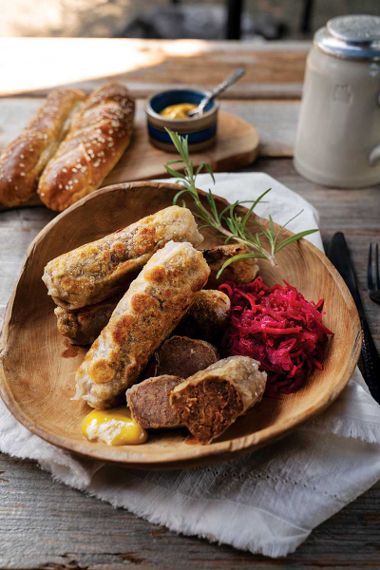
The trick to these plant-based sausages is rolling them in rice paper wrappers before steaming and grilling them. The rice paper creates a translucent coating similar to sausage casing, but without pork. These are best served with grainy German mustard (preferably stone-ground) and sauerkraut (look for unpasteurized versions or make your own), but they’re also great sliced into pieces and cooked into a tomato-based barbecue sauce with curry powder—a traditional currywurst!
Best bratwurst tips
It might seem like a lot of steps to wrap the sausages, steam them, and grill them, but if you skip the steaming, the rice paper wrappers become brittle on the grill, which isn’t necessarily a bad thing, but isn’t very sausagelike. If you skip the grilling, the outsides will be gelatinous, which is definitely not sausagelike!
To steam bratwurst, wrap each rice paper-rolled sausage in parchment paper and twist the ends like party crackers, securing each with twist ties or rubber bands. Or place rice-wrapped sausages directly on parchment-lined steamer basket, cutting extra strips of parchment to keep sausages from sticking together. Cool sausages thoroughly before removing from parchment-lined steamer basket.
Chia tips and tricks
If you don’t have ground chia seeds, grind whole seeds in a spice grinder or blender, or crush them well with a mortar and pestle. This improves the texture of the sausage. You can also use ground flaxseeds.
Nut swaps
You can replace the walnuts with hazelnuts or make the recipe nut free by using sunflower seeds.
Vegan Bratwurst-Style Sausages with White Beans and Walnuts
Ingredients
- 3 Tbsp (45 mL) ground chia seeds (see tip)
- 1/4 cup (60 mL) water or beer
- 1/2 cup (125 mL) walnut halves
- 3/4 tsp (4 mL) salt
- 1/2 tsp (2 mL) smoked paprika
- 1/2 tsp (2 mL) dried marjoram
- 1/4 tsp (1 mL) ground mace
- 1/4 tsp (1 mL) mustard powder
- 1/4 tsp (1 mL) ground ginger
- 1/4 tsp (1 mL) black pepper
- 1/8 tsp (0.5 mL) ground cardamom
- 1/8 tsp (0.5 mL) ground coriander
- 1/8 tsp (0.5 mL) crushed caraway seeds
- 1/4 tsp (1 mL) cayenne (optional)
- 1 tsp (5 mL) extra-virgin olive oil
- 1 shallot or small onion, diced
- 3 garlic cloves, minced
- 1 1/2 cups (350 mL) cooked or canned (rinsed and drained) white beans
- 1 cup (250 mL) regular or gluten-free breadcrumbs
- 1 Tbsp (15 mL) tomato paste
- 1 Tbsp (15 mL) gluten-free soy sauce or coconut aminos
- 8 large rice paper wrappers
Nutrition
Per serving:
- calories135
- protein6 g
- total fat5 g
- sat. fat1 g
- total carbohydrates18 g
- sugars2 g
- fibre4 g
- sodium430 mg
Directions
01
In small bowl, mix ground chia seeds with water or beer. Set aside to thicken.
02
In large skillet, toast walnuts over medium heat for 5 minutes or until aromatic, stirring frequently so they don’t burn. Transfer nuts to plate to cool. Measure spices into small bowl and set aside.
03
In the same skillet, heat 1 tsp (15 mL) olive oil over medium-low. When hot, add onion and garlic and sauté for 3 to 4 minutes, stirring frequently. Add all spices and stir; cook for 2 minutes more. Add tomato paste, soy sauce, and 1 Tbsp (30 mL) water. Stir and scrape up sticking spices. Remove skillet from heat.
04
If using canned beans, drain and rinse them, then dry gently in kitchen towel.
05
In food processor or blender, pulse toasted nuts to rough pebbles. Add drained beans and skillet contents and pulse to fine pebbles. Some texture should remain.
06
Transfer to a bowl and stir in chia seeds and breadcrumbs. Using a 1/2 cup (125 mL) measure, form into 8 sausages, place on plate, and chill in fridge for 20 minutes. Add a little water if mixture appears too dry to shape.
07
Fill large, wide bowl with hot water and add one rice wrapper, massaging it until soft. Place wrapper on cutting board or oiled parchment paper and place a sausage horizontally in middle of wrapper. Fold bottom of wrapper over sausage, fold in sides, and continue to roll up the sausage. Repeat with remaining sausages, placing each on plate when done.
08
Steam bratwurst for 20 minutes (see “Best bratwurst tips”).
09
Preheat barbecue or grill. Brush grill with oil and unwrap steamed sausages from parchment. Grill for 2 minutes on each side, or until grill marks appear. Or pan-fry in large skillet with 1/2 tsp (2 mL) olive oil, turning regularly until golden, about 7 minutes.





